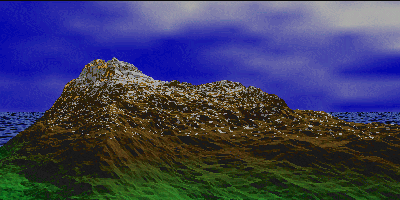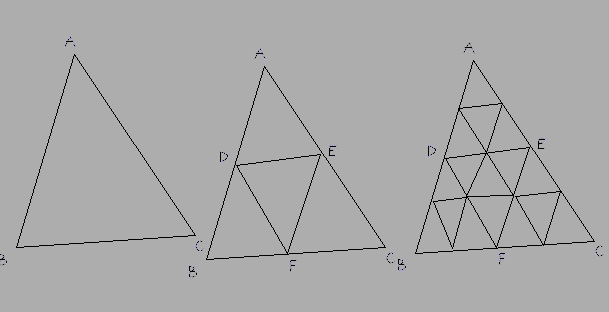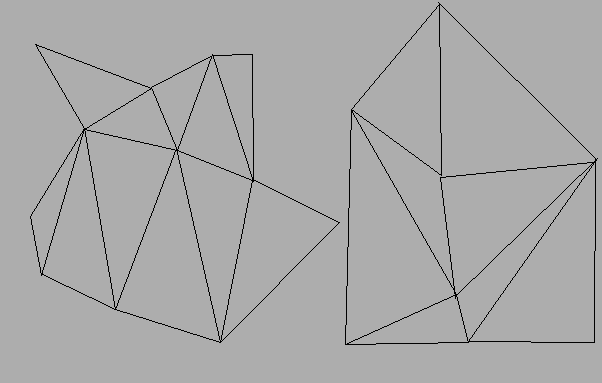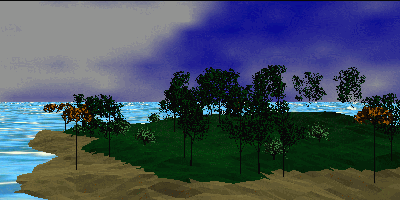
CS 426 Assignment 4
Recursively Defined Polyhedra and Fractal Mountains
Due 1159 PM Friday, November 22
Again: this assignment should be done in teams of two,
with the added restriction that you
cannot work with your partner from the previous assignment.
Introduction
In this assignment you will learn to build 3 dimensional solids
in recursive fashion. Initially, this will be similar to what
you did for Assignment 3. But, once you get comfortable with
the constructions, you will move to more complex geometries:
you will apply two techniques designed to generate
fractal mountains.
Part 1 -- Basic Subdivision
The first step of the process is to experiment with recursive
subdivision. This is not unlike what you did in Assignment 3
at first but the extension makes it vastly different.
First you must apply recursive subdivision to a triangle to get
into the spirit of the assignment. One level of the subdivision process
makes 1 triangle into 4. This is done by placing vertices at the midpoints
of the 3 sides of the triangle. These vertices are then connected resulting
in 4 triangles. It is very important in what follows that you do this by
identifying triangles and not just constructing subdividing lines.
We show here the first 2 generations generated from the triangle ABC.

To begin your work on this assignment, write a program that allows a
user to create a triangle
and then subdivide it for a specified number of generations.
You need to support triangle creation in a variety of ways.
The user could either enter mouse clicks for the 3 vertices or
could choose from a palette of popular triangles you provide.
Once the triangle has been created, you will allow the user to
select the number of generations. You then recursively
subdivide the triangle for that number of generations.
To be sure that you have the picture correct, colour each new triangle
in a different colour.
Part 2 -- Subdividing more complex Shapes
The second step in the assignment is to perform recursive subdivision
on more complicated shapes. Instead of starting from a triangle,
start from a tetrahedron. Recall that a tetrahedron is a 3 dimensional
shape defined by 4 vertices, 6 edges and 4 triangular faces. To
move from generation 0 to generation 1, all 4 triangular faces are
subdivided resulting in 16 triangular faces. Generation 2 has 64
triangular faces, and so forth.
Once you feel comfortable doing this for the tetrahedron, allow the
user to enter a mesh of triangles, specify a number of
generations and proceed with recursive subdivision for
that number of generations. An arbitrary mesh is a collection
of triangles with the property that
pairs of triangles either connect along an edge (in which case
the same length of edge belongs to both) or at a vertex or not at all.
For example, here are 2 examples of meshes:

Once again, you will let the user enter the mesh
through mouse clicks.
You must identify adjacencies, so that you
know that an edge divides 2 faces and you can identify the faces.
You will probably want to record your result using the winged edge
data structure we discussed in class.
Part 3 -- Controlled Randomness -- Fractal Mountains
For the third part of the assignment, you are going to generate fractal
mountains by 2 different methods.
The first method builds off of the mesh done above. You add the
ability to specify a z coordinate for each vertex. Thus, the mesh becomes
what is known as a terrain. Now, you can apply recursive subdivision
to your terrain to generate a mountain range. To do so, you might
want to vary the number of generations you use at each location
depending on whether the mountain range is meant to be smooth or rough
there. Part of this problem involves experimentation until you achieve
a mountain range that you like.
For the second part of the mountain generation, you will introduce randomness
as an aid in generating a mountainous terrain. Choose a value alpha
between 0 and 1 (make this value changeable by the user).
Everytime you take a midpoint of a segment, instead of
merely choosing the midpoint, create a sphere about that midpoint.
Let the radius of the sphere be alpha times the length of
the segment. Now choose a point at random in the sphere and use it
to replace the midpoint. In so doing, you are introducing
randomness into the situation. Now repeat the first 2 parts of the
assignment (recursive subdivision of a triangle and of a tetrahedron)
with this randomness. When you have done so, apply randomness to
the recursive subdivision of terrains. The goal again is to generate
the perfect mountain.
An easy hack that will help you is to assign colour based on elevation.
You might want to have a snow line and colour varying depths of snow
above that elevation. You might want to locate some small flat
regions and colour them as mountain lakes. The very industrious
will find a method of generating trees (not hard) and have trees
on the mountain up to the tree line. The tree heights will want
to decrease as the elevation increases.
Output file
We'll be using the output of this assignment as input for the next
one. You will need to implement a "save" feature which allows the
user to save the current mesh to a file. The file format is in
plain ASCII, with, starting at the first line:
max_vertices n
on the first line, with n replaced by the
number of vertices in your mesh
vertex x y z
on subsequent lines, one for each vertex
tri v1 v2 v3
one of these for each triangle, where v1,
v2 and v3 are indices into the
vertex array, starting at index 0. Make sure that the
vertices of each triangle
are sorted in counter-clockwise order (when
viewed from above)
Keep in mind that you'll need to add a few more lines to your output
function later on (for the 5th assignment).
What to submit
- Part 1: a separate program, which shows both "regular" and random
subdivision of one, user specified, triangle
- Part 2: a separate program, which shows random subdivision of
a tetrahedron
- Part 3: a separate program, which generates your fractal mountains.
- a makefile which makes all three parts in one go
- a README which explains any obscure/cool features that your
program has
Reading
- Hearn & Baker, paragraph 10-18: pp. 362-387
- lecture notes on winged edge data structure
- OpenGL Programming Guide, chapter 3, on viewing
Grading
The assignment will be graded for correctness, for code quality and for
aesthetics. You will lose points if it is clear that you merely completed
the assignment and did not try to generate elegant mountains.
The grade breakdown will roughly look like this:
- part 1: 1 point
- part 2: 1 point
- part 3: 8 points
Extra credit: the prettier your mountains are, the more points
you score...
Last year
Last year four graduate students wrote a "scenery designer" as their
final project. The image at the top of this page is output from their
program, as is this one:
Take a look at their
scenery designer web page.
 CS426, CS Department, Princeton University
Last modified: Thu Nov 14 19:00:36 1996
CS426, CS Department, Princeton University
Last modified: Thu Nov 14 19:00:36 1996



